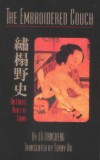 |
The Embroidered Couch
by Lü Tiancheng, translated by Lenny Hu
Arsenal Pulp Press, 2001
Reviewed by Aidan Baker
Reviewing erotica is not particularly the easiest of tasks. Considering it's relatively difficult to find much, if any, literary merit in most erotic novels. I'm not sure I can name many authors who have successfully created a legitimately literary erotic novel (though Nicholson Baker's FERMATA does come to mind…). So-called classic works of erotica like John Cleland's FANNY HILL are perhaps only classic because of a certain prurient historical interest; because it's titillating to know how Elizabethans had sex. Considering the florid and sometimes downright laughable language used in FANNY HILL (cloven places and purple majesties, anyone?), I'm not sure you could consider it particularly literary.
The same holds true for THE EMBROIDERED COUCH, a 'notorious classic' in Chinese literature, never before available in English. The work is attributed to Lü Tiancheng, a well-known playwright of the Ming Dynasty, and was originally published in the 17th century and subsequently banned on many occasions throughout history. Its story centres on three main characters; Easterngate, his young wife Jin, and Easterngate's companion, Dali. By day Dali and Easterngate "were brothers, while at night they made love as if they were husband and wife" (p25), the pseudo-incestual suggestion simply adding spice to their relationship. Easterngate, out of a presumably lascivious motivation, encourages Jin and Dali to start an affair and then they all have sex with each other and the servants and neighbours and pretty much anyone else they happen to be around. Eventually Easterngate becomes dissatisfied with his libertine existence and seeks repentance. But that doesn't happen till the very end of the book.
"I am fully aware that pointing out its historical value alone might not be convincing enough to those who doubt that it has literary merit," says translator Lenny Hu in his introduction. No, it doesn't. But, then, in my mind the historical is the main thing of value to THE EMBROIDERED COUCH. In defense of the literary merits of the novel, Hu describes it as a "fine work of mimesis" and a "novel of manners within which is enclosed a lurid story of sexual adventures," which unabashedly addresses sexual mores and practices. Sure, it is a relatively true-to-life work and it is certainly unabashed and lurid, waving the standard euphemisms (jade stalks and female orifices anyone?) for genitalia, but it also contains sex scenes that tediously go on for pages and stereotypical references to giant penises:
'Dali's dick is indeed stunning,' Easterngate stressed. 'I myself can't but give a cheer upon seeing it, not to mention women. It measures a good 8.3 inches in length and four inches strong in diameter. It's hard as an iron club and hot as burning fire.'
I wouldn't exactly describe the above passage as poetic. It probably wouldn't seem out of place in PENTHOUSE LETTERS. Frank, clear writing might be admirable (particularly when it comes to sex), but it doesn't necessarily make for interesting writing.
Perhaps it's beside the point to expect high literary quality in a book whose primary purpose, presumably, is titillation. But doesn't something well-written and well-crafted turn you on more than a string of worn-out scenarios and hyperbolic detail? I suppose you can grant THE EMBROIDERED COUCH praise for using those scenarios first, but that simply returns us to the historical merit argument. It would be nice if had literary merit too.
Aidan Baker is a Toronto writer & musician. Here is his website:
http://listen.to/aidan.
|